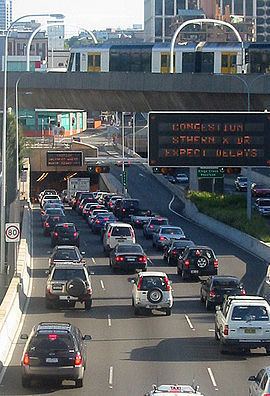Type Motorway | Length 6 km (3.7 mi) | |
 | ||
Opened 19 December 1999 (Completed in July 2000) Formerroute number Metroad 1 (1999–2013)Entire Route North end Cahill ExpresswayWoollomooloo, Sydney | ||
The Eastern Distributor is a 6-kilometre (4 mi) long motorway in Sydney, New South Wales, Australia which is 75.1% owned by toll road operator Transurban. Part of the M1, it links the Sydney central business district (CBD) with the Airport. The centre-piece is a 1.7 km (1.1 mi) tunnel running from Woolloomooloo to Surry Hills.
Contents
Map of Eastern Distributor, New South Wales, Australia
The motorway is tolled in one direction (northbound) with the toll plazas at Woolloomooloo and at the William Street exit. As of February 2017, the toll for cars/motorbikes is $6.95 and $13.90 (including GST) for other vehicles. The toll will be removed in 2048 when the contract held by Airport Motorway Limited (AML) expires.
This motorway is part of the 110-kilometre (68 mi) Sydney Orbital Network. For about half its length, it is in a trench inside South Dowling Street. The motorway provides a southbound exit for Lachlan Street/Dacey Avenue, a northbound exit for Cleveland Street, northbound entrance ramp from Cleveland Street and connections to William Street. There are also connection to the Cross City Tunnel, giving motorists direct connections under the city to the Western Distributor. There are also northbound/southbound entry/exits to Moore Park Road and Anzac Parade. Southbound motorists were later found to be entering the Eastern Distributor from the Cross City Tunnel access point and immediately attempting to cross three lanes for the Anzac Parade off-ramp. Permanent traffic obstacles are now in place to prevent this and users are now referred to the Lachlan Street/Dacey Avenue exit instead.
History
The need for an Eastern Distributor was first talked about in 1951. It was not until the election of the state Labor government in 1995, led by premier Bob Carr that the project was initiated.
At 6 kilometres (3.7 mi) in length, the Eastern Distributor was built to link the Sydney central business district with Sydney Airport via the already existing Southern Cross Drive (freeway). It was designed to ease congestion and to reduce the time to travel from the city to the airport. Construction involved 5,000 workers and was undertaken by Leighton Contractors for Airport Motorway Limited. Privately built, the Eastern Distributor is also privately owned and operated by Transurban, with state government planning, support and management during construction. At a cost of A$730 million, the motorway was opened on 19 December 1999, except for the William Street on and off ramps which were opened on 23 July 2000, just in time for the Sydney 2000 Summer Olympic Games. The term of private ownership is 48 years after which the road will revert to government ownership on 23 July 2048.
Two separate tunnel subcontractors began excavating the northbound tunnel in January 1996, working at either of the tunnel—that is, Surry Hills and Woolloomooloo. Seven roadheaders were utilised for the tunnel boring, with the rock ceiling then reinforced with rock bolts and shotcrete. On 4 December 1998 the two teams were shaking hands in the middle–30 metres (100 ft) beneath Taylor Square. Actual construction started in August 1997 and by March 1999 all digging was complete, after 400,000 cubic metres (520,000 cu yd) of soil, largely Sydney Hawkesbury Sandstone was removed–equal to 40,000 truckloads.
The project's centrepiece is the 1.7-kilometre (1.1 mi) piggyback tunnel under one of Australia's most densely populated urban areas, necessitated due to the requirement of three lanes in each direction within the existing roadway corridor. The unique double-deck, three lanes per direction design comprises a large, single tunnel excavation. At mid-height through the excavation, a precast concrete ledge forms the base of the northbound tunnel, with the southbound tunnel slotting below. As a result, only one tunnel roof was created with the lower southbound carriageway built in a slot. According to the Australasian Tunnelling Society, no records are available of any piggyback tunnel (rail or road) where the upper carriageway has been carried on prestressed concrete planks resting on sidewall ledges. In the main tunnel there is a central length of 0.5 kilometres (0.3 mi) where the span is typically greater than 17 metres (56 ft), and of note, there is no record of any road tunnel with spans greater than this where permanent roof support comprises rockbolts and shotcrete only and with vertical unsupported sidewalls of rock. The tunnel's claim to fame at the time it was built was that at 24.5 metres (80 ft) across at its widest point, it was the widest tunnel in the world. This point occurs where the William Street on ramp tunnel merges with the main tunnel. At 14 metres (46 ft), the tunnel is also notably large from the ceiling to the floor.
The tunnels of the Eastern Distributor are equipped with the full range of services required in a modern road tunnel for the comfort and safety of the road user: lighting, ventilation, drainage, closed circuit television surveillance, fire fighting and emergency control systems.
Toll history
This is a history of the toll charges:
